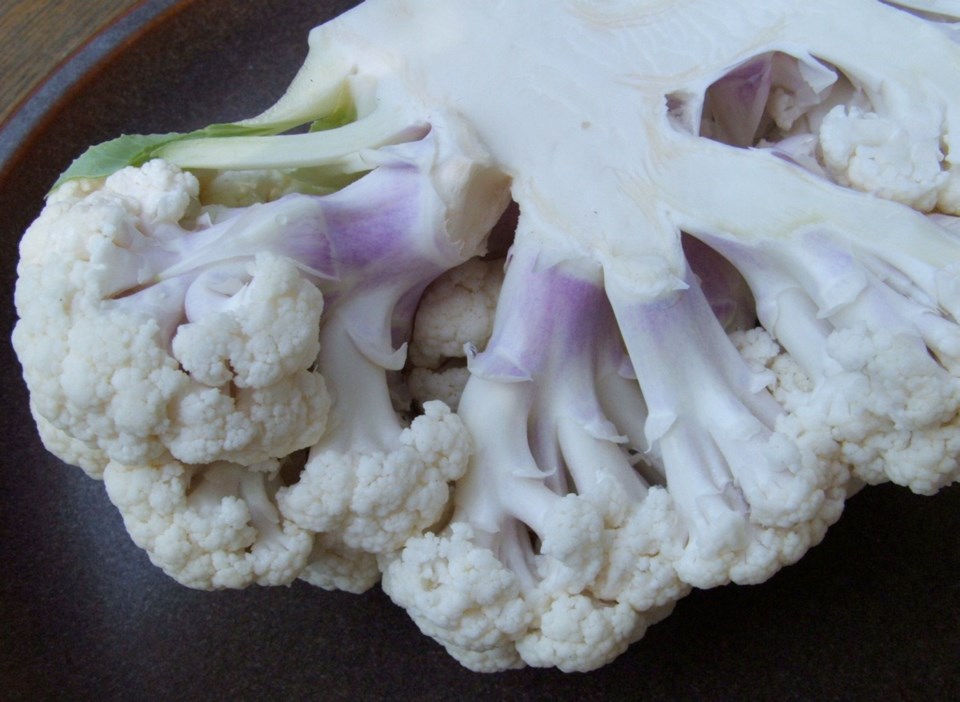Dear Helen: My cauliflower plants grew well and I’d harvested one head by mid-month, but the head on one plant turned purplish. Does this colouring render the cauliflower harmful to eat?
H.L.
That’s been a common issue this year. One of my neighbours pulled up and composted all her cauliflower plants because the heads had taken on purplish tones. Too bad, because they were perfectly safe to eat.
Cauliflower is highly heat-sensitive. Most plants thrived in our long, cool, moist spring and early summer, but the sudden onset of heat and strong sunlight has caused in some plants the common reaction of purple colouring.
Certain varieties, such as the popular Snow Crown, are more susceptible than others. I’ve had Snow Crown heads become tinged with purple or purplish-pink in hot, sunny weather.
Dear Helen: I was interested in your descriptions of dense, close-space planting to make the best use of a limited area. I have experimented with planting like this and found watering can be challenging. The dense foliage canopy of substantial plants such as tomatoes, broccoli and pea vines tends to divert water away from the plants’ roots. How do you manage to keep the root areas of closely spaced plants moist?
A.T.
Soaker hoses laid between the rows is one way to keep the sheltered soil watered. I use a more hands-on method.
To reach in and give a gentle but thorough dousing of the soil between two four-metre pea vine rows and between a pea row and another of staked tomatoes, with just a one-metre space between the rows, I’ve used a long-handled watering wand with an on-off lever.
That first pea planting is finished and removed now and I’m picking the second planting, but the narrow alley between the peas and tomatoes is easily kept well moistened, at ground level, with my handy extra-long watering wand.
To some, such a method might seem antiquated and inefficient, yet the time spent wielding that wand is somehow easeful.
I treasure such blessedly undemanding tasks. They are sublime opportunities let the gaze wander, listen to the bees humming, and rest the mind.
Dear Helen: Quite a few years ago, you shared a recipe for lavender cookies. I used that recipe so much, my copy has become unreadable. Could you repeat it? I love these cookies and they are a favourite of my family and friends.
T.W.
Lavender shortbread
1 1/2 cups butter at room temperature
2/3 cup sugar
2 Tbsp chopped lavender florets
1 Tbsp chopped fresh mint
2 1/3 cups flour
1/2 cup corn starch
1/4 tsp salt
Cream butter and sugar. Add lavender and mint. Mix until light and fluffy, about three minutes. Add flour, corn starch and salt. Beat until combined.
Divide the dough in half, flatten into squares, and wrap in plastic. Chill until firm. On a floured board, roll or pat out each square to a thickness of 3/8 inch. Cut the dough into 1 1/2-inch squares or rounds, and transfer to baking sheets that are covered with parchment or brown paper. Space them one inch apart, and prick each cookie several times with the tines of a fork.
Bake 20 to 25 minutes at 325 F, until pale golden. Do not allow the shortbread to brown.
Cool slightly, transfer to a rack, sprinkle with lavender powdered sugar if you wish, and store in sealed containers.
Lavender powdered sugar is made by putting a few lavender flowers in a sealed pint jar of powdered sugar for a day before using the sugar.
North Saanich parks. Friends of North Saanich Parks is an organization dedicated to repairing and preserving local ecosystems.
They offer a safe place for community members to connect and learn new skills as they volunteer to help out with the removal of invasive plants. The group provides a supportive environment as well as necessary equipment and training.
For interested new volunteers, the next work parties will take place on the following Saturdays from 10 a.m. to 2 p.m.: Aug. 1 at Nymph Point Park; Aug. 15 at Denham Till Park; Aug. 29 at Lillian Hoffar Park. fnsp.ca
Weekend column: I’ll be taking a summer break from writing a column on the upcoming holiday weekend. I’ll be back next Wednesday.



